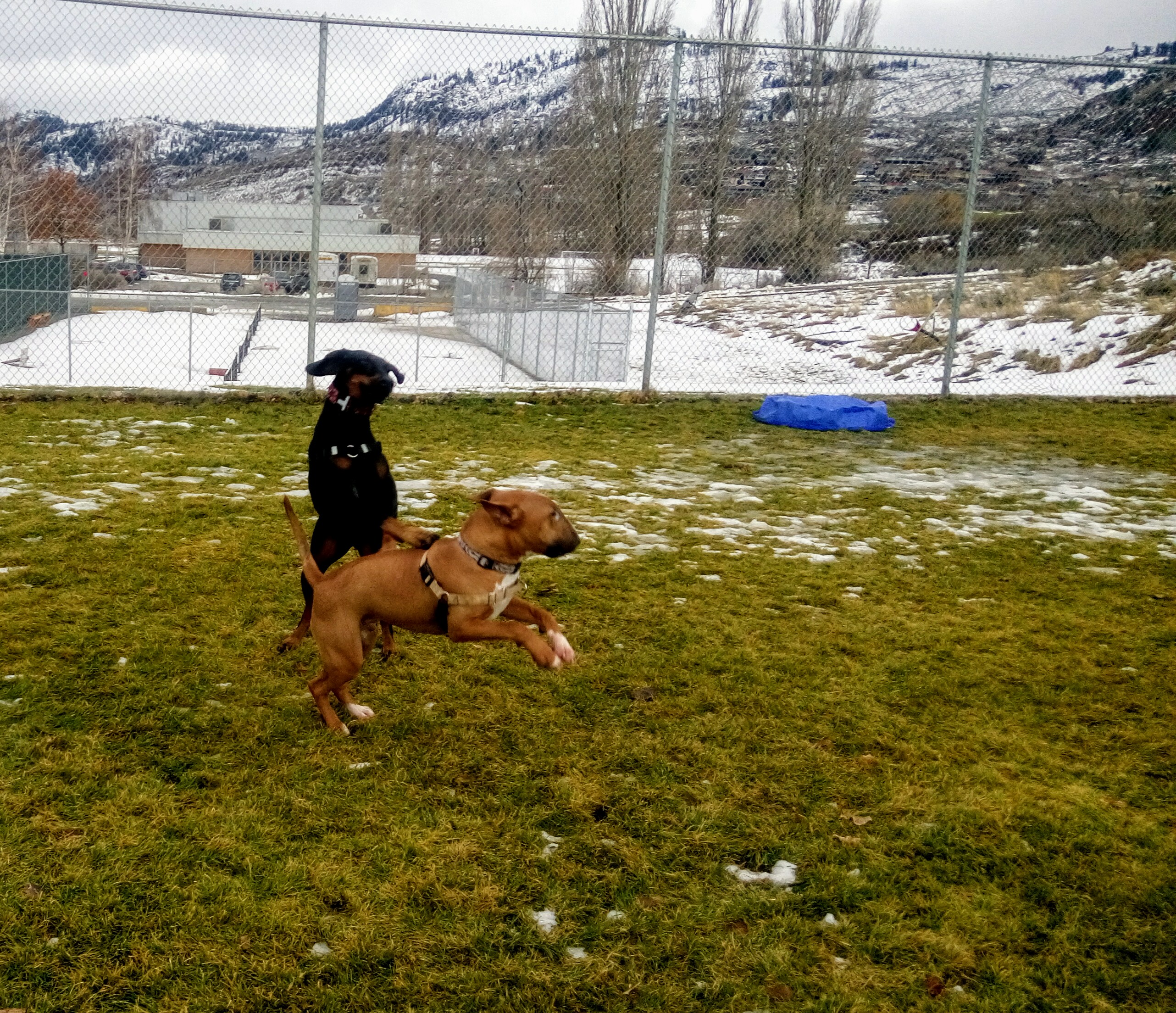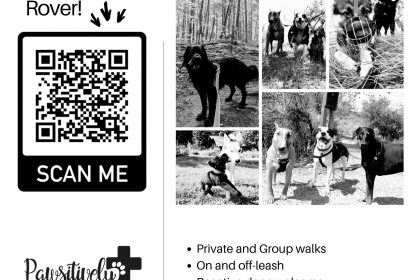Crate training is ubiquitous in North America with pet dogs. It is incredibly common to see dogs being crated while their owners are at work all day (8 hours plus commute time, typically) as well as overnight. Crate training has also become synonymous with house training – common wisdom being that a puppy won’t pee where they sleep, so if they’re in a crate they’re less likely to potty in there. Many people also believe that crate training is actually beneficial to dogs, as it gives them a den to have as a safe space – logic being like wolves in the wild.
This all sounds pretty good, right? So where’s the controversy?
Did you know…? Some dog and crate myth busting!
So, first and foremost, dogs aren’t wolves. More importantly, the self-domestication of dogs happened a very long time ago – I’m talking, 15,000+ years ago. This means dogs have been coexisting with humans for a long, long time. Not as wild animals in dens. This means they are very social creatures, and crates are, by definition, isolating.
Another interesting fact: even wolves don’t use dens the way a lot of people nowadays use crates. Wolves tend to use dens only when they have young pups who can’t travel yet; once grown, wolves travel 20+ miles a day. More importantly, these dens always have easy escape routes, unlike the modern crate that locks dogs in.
Furthermore, daily crating is a very cultural thing; in Finland and Sweden, for example, crating a dog overnight or while the owner is at work all day is illegal. In the EU as a whole, crates are used much less than here in America.
So, what’s the deal? Why do we crate train?
Here’s a bit of a hard pill to swallow: human convenience is the first answer here. I know it is easier to think “dogs love crates! They feel safe, like it’s a den!” and you’re doing it for them, but realistically, crates are for owner convenience. You don’t need to worry about your dog chewing something they shouldn’t (expensive for you and dangerous for them!), peeing on your carpet, etc. And honestly? In moderation, that’s okay! I get it. Puppies can be exhausting and sometimes you just need to put them away and take a bubble bath and not have to think about them. It’s okay. Does that “put them away and not have to think about them” have to be a crate? No. Can it? Sure!
Crate training can be a great skill for a dog to have.
What? Surprised to hear that coming from me? I mean it!
Dogs who do sports are often crated during trials, and it’s important they can relax and decompress in that space.
Ever need to fly with your dog? Whether in cargo or cabin, they’re going to have to be crated. And, in cargo, it isn’t recommended to give them any sedatives or drugs, so they’d better be able to settle comfortably in the crate on their own.
Is your dog going to stay at the vet for surgery? Yep, you guessed it, they’re going to be crated. How much better will their vet experience be if that’s something they’re comfortable with?
Groomer visit? Probably crated.
I could go on, but the point is this: being able to be comfortably crated is a great skill for a dog to have. But, being able to be comfortably crated does not mean being crated daily or even on a regular basis.
Big, Scary, Crate “Training” Advice
Here are the things that really worry me about modern crate training; these are pieces of advice I still hear floating around regularly – heck, some of them I used to even believe myself. And they can and do cause real damage to dogs:
- Scary Training Advice #1: When house training, you must crate your puppy any time you aren’t actively interacting with them. Furthermore, if they are struggling with housetraining, their crate should only be big enough for them to stand up, move in a circle, and lie down.
If you are using a crate as a management system for a puppy – or any dog, really – bigger is better. Full stop. Being able to stretch their legs, move around, reposition, etc. is all really important. When thinking about the smaller is better idea, I worry both about the dog physically – their joints and growth and ability to stretch – and emotionally. I always think about it like if I’m on a road trip in the car and I really have to pee and the driver won’t stop and let me so my options are to hold my bladder as long as I can and be uncomfortable and then finally maybe end up peeing my pants and having to sit in it in the car. That would be awful. Is it a perfect analogy, perhaps not. But you take my point. If you are housetraining properly – crate or not – hopefully your puppy doesn’t get to that point of desperation, but if they do, they should reasonably be able to pee and not have to sit in their own filth. You can clean it up and move on. Accidents happen.
- Scary Training Advice #2: Don’t ever let your puppy out of the crate if they’re crying! It teaches them to cry more.
Technically, this one has some truth to it. A dog certainly can learn to demand bark (in any situation, not just the crate!) and, if they get what they wanted, they learn that the barking worked. That said, often times I find dog owners don’t actually do the “train” part of “crate train”. They just put their dog in a crate and expect them to fall asleep. And you know what? Sometimes that works. But more often, in my experience, the dog finds it scary and isolating and that isn’t training. Training happens slowly and at a level the dog is comfortable with; so, if you are crate training properly, your dog won’t want to bark or cry because they’re comfortable with what is happening.
An analogy I use often with my clients is that dogs barking or whining is similar to a toddler crying. If my toddler is crying because I won’t buy them a chocolate bar, no, I’m not going to just buy them a chocolate bar to get them to stop. If my toddler is crying because they fell and hit their head, of course I’m going to hug and comfort them.
Using this analogy, if you dog is having a meltdown in their crate, they need comfort and you need to reassess your training strategy and goals.
I basically never recommend letting a dog “cry it out”; if they are crying or barking, either a) they have an unmet need, b) they aren’t trained to the level I thought they were, or c) they’re uncomfortable or fearful. I cannot recommend enough giving this article a read: Self Soothing & Cry it Out are Neurologically Damaging and Here’s Why. Crying it out can cause real long term damage.
Leaving an animal to cry will make them less healthy, more difficult to manage, anxious and probably more fearful. These traits get passed down to the next generation. The attitude that dogs have to be “taught to be independent” is quite frankly coming back to bite us in the behinds. Why? because by forcing independence, we are actually creating the opposite, dependence. Studies have shown that giving them what they need, leads to greater independence, greater exploration and better confidence when left (Hewlett & Lamb 2005 hunter gatherer childhoods). Conditioning an animal to expect that his needs are not met, means he is far more likely to exhibit unhappy, aggressive & demanding behaviours and is far more likely to vocalise to get his needs met. This deep sense of insecurity is likely to stay with him for the rest of his life.
From “Simply Behaviour”‘s “Self Soothing & Cry it Out are Neurologically Damaging and Here’s Why”
My experience? Dogs who are overly confined are *more* likely to have issues with anxiety and isolation; dogs who are overly confined are more likely to be destructive in the home due to unmet needs. Similarly to how dogs who are on a long line are less likely to pull on leash. Counterintuitive but true!
My own Doberman, Athena, has extreme confinement anxiety. When she was a puppy, I was told and followed the “only small enough for them to stand up and turn around in, and ignore crying” for about two weeks. Maybe not even. She, at 8 weeks of age, would cry and scream literally all night and bite and paw her crate until she made herself bleed, while I’d be in bed sobbing thinking I was doing what was right.
I still haven’t untangled that mess, and frankly, I don’t work on it much. She lives a crateless life. But, we do occasionally practice “Crate Training” – and, for her, that means we never even close the door. That is too hard for her. But she will willingly go in… and that’s huge progress for her. Here’s a very bad quality, very old video of what crate training looks like with Athena – not just put-them-in-and-hope-for-the-best:
- Scary Training Advice #3: Crate training as a solution for Separation Anxiety
Separation Anxiety is a really tough one to deal with. I rarely take on SA cases because they are so complex and a real panic disorder. There are trainers out there who specialize in SA exclusively, and I’m typically more than happy to refer on to them. That said, a lot of dog owners who have a dog with SA often jump to crating their dogs because a symptom of SA can be extreme destruction and pottying in the house. It’s a pretty heartbreaking panic disorder to see in dogs. That said, for dogs with SA, crating is often very stressful and can even make their SA worse; these are dogs who already really struggle with being isolated, and crating just further isolates them and confines them. It is not unheard of for these dogs to hurt themselves trying to escape their crate or even practice self harming behaviours.
For whatever reason, most dogs who hate being left also hate being left in a crate. They hate that more.
Julie Naismith
In speaking with Beth Berkobien, Separation Anxiety specialist and owner of Rehab Your Rescue, she had this to say about crate training:
While crate training is a very useful tool for many dogs, it can be overused and is not ideal for dogs that have separation related behaviors. When we see dogs with confinement anxiety, I often recommend getting the dog out of the crate. What we find is that the dogs are not misbehaving, but are having a hard time emotionally…. so, we need to work on the emotion and not the behavior. Confinement anxiety can happen in any dog, even puppies, and it’s not alway a product of training but can have a genetic component.
Beth Berkobien
And this, I think, has one very important and impactful takeaway: “the dogs…are having a hard time emotionally.” We need to stop being so focused on the “bad” behaviour – pottying inside, destruction – and remember that these are a symptom of a panic disorder rather than just behaviour without a cause. Dogs with SA are having a hard time emotionally, and locking them in a crate will not help their emotional state.
So, What Do We Do With All This?
I think the big takeaway I want people to consider is this: crates can be an excellent management tool, in moderation. But remember the importance of moderation, and remember that dogs are and have been very social creatures with humans for thousands of years, and while independence and confidence can be good things, isolation isn’t.
Further, I’d encourage you to consider that while management is a big, important piece of the training puzzle, it isn’t the only one.
If your dog potties in the house, a crate can prevent the messes from being everywhere – but it doesn’t actually teach the dog not to potty in the house and to potty outdoors. Training does that.
If your dog is destructive, a crate can remove their access to things they shouldn’t have, but it doesn’t teach them not to be destructive. Increasing exercise and enrichment, and teaching what they are allowed to chew does.
Teaching them how to appropriately exist in the home is far more effective in the long term than managing their access to the home.
And finally, remember: crates aren’t the only management tool in the world. You can puppy proof your house; you can use baby gates and doors, you can get a dog walker or doggy daycare, etc. The solutions are endless.
Recommended Resources
Some of these have been hyperlinked already throughout the article, but for easy of access:
- “Crateless Life” by Laura Friis
- “When It Comes to Crates, Think Outside the Box” by Malena DiMartini and her entire website dedicated to Separation Anxiety
- “Crate Games” by Susan Garrett, which is the basis of how I started getting Athena confident around crates in the video
- “Wolf Ecology and Behaviour” by Western Wildlife Outreach, re: den instincts
- “Self Soothing & Cry It Out are Neurologically Damaging and Here is Why” from Simply Behaviour
- “Do We Crate Too Much” from Modern Dog Magazine
- “Is A Dog Crate Really a Den? How This Very American Practice Took Off.” The Pulse
- “Dogs Hate Crates: How Abusive Crate Training Hurts Dogs, Families & Society” by Ray & Emma Lincoln note: this book is overall not the best, especially with some of it’s training advice; however, it does have a lot of really great resources listed in it, as well as some really interesting food for thought about crating and puppy mills.
- “Why I’m so Passionately For and Against Crate Training” by Julie Naismith
- Crate Training from clickertraining.com [a “how to”]





This was very well written and provided links to a great wealth of information. It amazes me how often people just accept an idea without really studying it further. I generally start crate training in the car, taking short rides to place that might be interesting to the pup. My dogs spend a great deal of time in crates in the car because I do Search and Rescue which involves working with one dog at a time. When at home my dogs are not crated much unless a delivery is expected or people are coming over to work on the house.
Oh wow, S&R is so fascinating! Good for you. And thanks for the thoughtful comment!
LOVE THIS!! Have sent it to friends who are new pup parents!
Thank you so much! I hope they find it helpful!